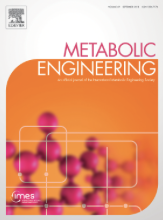| Title | Optimal cofactor swapping can increase the theoretical yield for chemical production in Escherichia coli and Saccharomyces cerevisiae. |
| Year of Publication | 2014 |
| Authors | Z.A. King; A.M. Feist |
| Journal | PLoS Comput Biol |
| Abstract | Maintaining cofactor balance is a critical function in microorganisms, but often the native cofactor balance does not match the needs of an engineered metabolic flux state. Here, an optimization procedure is utilized to identify optimal cofactor-specificity "swaps" for oxidoreductase enzymes utilizing NAD(H) or NADP(H) in the genome-scale metabolic models of Escherichia coli and Saccharomyces cerevisiae. The theoretical yields of all native carbon-containing molecules are considered, as well as theoretical yields of twelve heterologous production pathways in E. coli. Swapping the cofactor specificity of central metabolic enzymes (especially GAPD and ALCD2x) is shown to increase NADPH production and increase theoretical yields for native products in E. coli and yeast-including l-aspartate, l-lysine, l-isoleucine, l-proline, l-serine, and putrescine-and non-native products in E. coli-including 1,3-propanediol, 3-hydroxybutyrate, 3-hydroxypropanoate, 3-hydroxyvalerate, and styrene. |
| URL | http://www.ncbi.nlm.nih.gov/pubmed/24831709?dopt=Abstract |
| PubMed ID | 24831709 |
